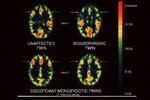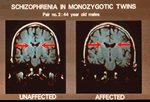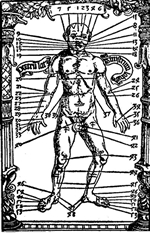
For more details about
Schizophrenia
log-on to:
Web site design company
Powered By:
|
Source
Title: "Comprehensive Text Book of Psychiatry" A. M. Freedman, M.D. H.I. Kaplan, M.D. The Williams & Wilkins Company. 1967 Baltimore |
|
Presentation created by Sandra Marchand-Smith Psychology 120 Powered by www.smithwebdesign.com |
|
The problem of schizophrenia remains an urgent challenge to the researcher, clinician, and sociologist alike. Today, etiological research is actively exploring four major factors:
In fact, during the 19 th century a violent controversy developed between those psychiatrists who, as Griesinger had first emphatically proclaimed, believed that all mental disorders were due to physical brain disease and those who thought they were due to a dynamic, psychological struggle between freedom and obstacles, sin and guilt, and other psychological forces. Heinroth derided his opponents of the somatological school because they looked on the human mind "as a cadaver which one could cut pieces with a knife, or as a chemical compound which could be broken down into elements, or as a mechanical contraception, the working of which one could calculate with help of mathematics." The factor of heredity as a possible cause of psychosis was also considered by psychiatrists of the early 19th century. Morel describes the case of a psychotic boy whose mother had been insane and whose grandmother had been eccentric, suggesting heredity as a definite etiological factor.
Is
all mental disorder constitutional and genetically determined,
or is it acquired through traumatic experiences in early childhood?
The debate between somatogenic and psychogenic schools of thought
on the causes of mental disorder and the nature-nurture controversy
still go on today. Biological Cause: Heredity is the most well
established risk. People who have immediate family members with
schizophrenia have a 10% chance of developing it, ten times that
of the general population. Other personality disorders, including
those with psychotic symptoms, also seem to be more prevalent
in families with schizophrenia. Despite the chance for inheritance,
the number of children born to parents with schizophrenia doubled
in the first 50 years of the 20th century.
Neurological Cause: The theory that schizophrenia
is partly a result of abnormal
brain function is useful in understanding its biological
basis. Underactive frontal lobes and overactive parietal lobes
are thought to cause some of schizophrenia’s associated symptoms.
For example, when frontal lobes are underactive, planning, organization,
and volition are all impaired. Frontal lobe abnormalities are
probably related to schizophrenia’s negative symptoms. Parietal lobes are involved in sensory perception, like voice recognition, the ability to distinguish patterns, and spatial orientation. Overactive parietal lobes may cause distortion of these senses, which is seen in many people with schizophrenia. Parietal lobe abnormalities are probably more closely related to positive symptoms. Abnormal brain structure is found consistently in people with schizophrenia. This includes enlarged ventricles and asymmetrical hemispheres. Computerized functional imaging of the brain has found decreased blood flow to the frontal lobes of people with schizophrenia. These types of brain abnormalities forecast certain symptoms, like loss of attention, difficulty with abstract thinking, and the inability to solve problems. Some evidence suggests that infants who experience birth trauma or complications while in the womb are at greater risk for schizophrenia. Maternal illness may play a part as well. A mother who contracts a virus like the flu, especially during her second trimester, may increase the risk for her child. It is not known, whether the virus itself or the immune response to it increases the risk. Some studies have shown that winter birth may be associated with schizophrenia, especially during immune response and illness. Furthermore, viruses in the womb are more common during the winter months. This has led some researchers to consider intrauterine viral infection during the winter as a risk factor. The same link, however, is found for major mood disorders, like bipolar disorder.
The main support for the theory that too much dopamine causes schizophrenia is the fact that antipsychotic medications, which are used to treat schizophrenia, block dopamine receptors. The medications are designed to bind to dopamine receptors in the brain, and their effects have helped many people cope with symptoms. Secondly, drugs that increase levels of dopamine, like amphetamines, often cause psychotic symptoms and a schizophrenic-like paranoid state. However, several factors challenge the dopamine hypothesis. For example, dopamine-related psychosis occurs in many disorders, not exclusively in schizophrenia. People with schizophrenia are not the only ones who respond to antipsychotic medication. Antipsychotic medication may not significantly affect the negative symptoms of schizophrenia, which suggests that there is more involved than abnormal dopamine levels alone. Moreover, dopamine levels might actually be lower rather than higher in the frontal lobes of the brain. At any rate, antipsychotic medication only treats the symptoms of schizophrenia; it does not eliminate its underlying causes. Environmental Cause Environmental factors and stress are thought to trigger the onset of schizophrenia. For example, moving, troubled relationships, problems at work, or substance abuse may aggravate the constellation of risk factors and lead to psychosis. |
|
|
|
Etiology: (etiological) The study or theory of the factors that cause disease and the method of their introduction to the host; the cause(s) or origin of disease or disorder. |
|
|
| What is schizophrenia? | What are the causes? | What are the treatments? |


 Venesection:
The practice of bloodletting has been used by almost all cultures
and societies at some point in their medical history. The controversy
over the usefulness of it has been raging since the fifth century.
It was considered to be part of the treatment for practically
every ailment that you can think of: asthma, spitting blood, bruises,
cough, consumption, contusion, convulsions, cramps, deafness,
delirium, epilepsy, giddiness, gout, whooping cough, hydrocephalus,
head ache, intoxication, lethargy, lunacy, measles, palsy, rheumatism,
sciatica, shortness of breath, and sore throat. It was also, though
not as commonly, used as a punishment and as a form of worship
to a superior power. In seventeenth century England, for example,
the use of bloodletting was very popular for the treatment of
hysteria. It was believed that hysteria gave rise to an accumulation
of "putrid humors" which impaired the organs whose function
it was to purify the blood and caused this physical affliction.
Bleeding and purging were the universal remedies for these humors
and so they were employed for the treatment of hysteria as well.
Synonym:
Venesection:
The practice of bloodletting has been used by almost all cultures
and societies at some point in their medical history. The controversy
over the usefulness of it has been raging since the fifth century.
It was considered to be part of the treatment for practically
every ailment that you can think of: asthma, spitting blood, bruises,
cough, consumption, contusion, convulsions, cramps, deafness,
delirium, epilepsy, giddiness, gout, whooping cough, hydrocephalus,
head ache, intoxication, lethargy, lunacy, measles, palsy, rheumatism,
sciatica, shortness of breath, and sore throat. It was also, though
not as commonly, used as a punishment and as a form of worship
to a superior power. In seventeenth century England, for example,
the use of bloodletting was very popular for the treatment of
hysteria. It was believed that hysteria gave rise to an accumulation
of "putrid humors" which impaired the organs whose function
it was to purify the blood and caused this physical affliction.
Bleeding and purging were the universal remedies for these humors
and so they were employed for the treatment of hysteria as well.
Synonym: